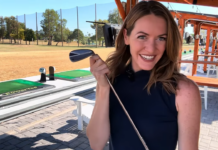Proper shoulder bend in the follow-through directly correlates to playing better golf
After teaching over 7 million golf lessons at GOLFTEC and studying the facts from our SwingTRU Motion Study, we know a proper finish position is directly correlated to playing great golf.
We also know two of the most important factors contributing to a proper finish position are attributed to how the hips and shoulders bend in the follow-through.
Tour players, for example, average 32 degrees of backward bend with their shoulders in the finish position. But the 30-handicap golfer averages just 3 degrees of backward bend.
The tour player’s hips are also positioned more toward the target than the high-handicapper, meaning the hips move ahead of the torso instead of behind.
These differences all boil down to more extension in the legs and arms with the better player in the follow-through; a key ingredient to create a faster swing speed and more consistent contact with the ball!
That means if you’ve ever been told to “keep your head down,” or if you struggle with back issues, flexibility or the ability to feel “balanced” in your finish position, read on because we’ve got the perfect drill to help your cause.
The Shoulder Bend Drill
In the following video, GOLFTEC’s Patrick Nuber illustrates key hip and shoulder bend differences in three different students.
When comparing the high-handicapper to the better golfer, shown in progression with the 35-handicapper, 20-handicapper and scratch golfer below (left to right), these two types of golfers often move their hips and shoulders in a completely opposite manner.

As Nuber explains, the more ideal hip and shoulder bend positions seen with the scratch golfer can be spurred on by a simple drill for the range or at home.
The Shoulder Bend Drill will not only help simulate the proper hip and shoulder bend movements in this manner, but with some consistent work can result in that tour-player finish position and playing your best golf!
How to do it:

1. Take your normal address position.
2. Stand straight up from this position (straightening your knees and back) and push your hips toward the ball. This movement should give you a slight backward bend.
3. Once you’ve achieved the slight bend, rotate 90 degrees toward the target line — this is your ideal follow-through position!
Editor’s Note: This is an updated version of the original article published on July 22, 2016.
VIDEO: The Shoulder Bend Drill
Not sure if this drill is right for you? Talk to a GOLFTEC Coach today!









Small comment…the photo of the women shows shoulder tilt an head still down. The next ,the man, has little or no shoulder tilt remaining and the head up. Both have their hips ahead their shoulders ie back inclination. perhaps a little confusing
Hi Dick, thanks for the comment! The article is defining the shoulders bending backward from just prior to impact into the followthrough. That backward bending of the shoulders helps in a myriad of ways (as Patrick’s video describes). To sum it up, keep your hips level to the ground, your legs relatively straight, and bend your shoulders back through impact and into the followthrough. The women pictured need to do all of these variables more.